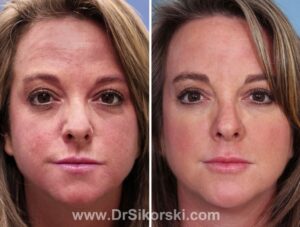
Who gets Actinic Keratosis?
A large majority of dermatology patients who have spent years in the sun, golfing or gardening or involved in outdoor sports, tend to have multiple Actinitc Keratosis’ on the face, chest, arms and legs. Men who have thinning hair or baldness will get them on the scalp.
How do I get rid of Actinic Keratosis?
The only effective way to get rid of AKs are to destroy these abnormal cell growths with intense cold or with a topical cream which contains specific chemicals. Single Actinic Keratoses on the face and body are most commonly destroyed by freezing them with liquid nitrogen spray (cryotherapy). This is the method most patients prefer when they have isolated AK growths. Those with broad scatters and large numbers of AKs will most often need to use a skin peeling acid followed with a topical chemo-agent such as 5-flurouracil (5-FU).
How does an AK Peel work?
Dr. Sikorski will use trichloracetic acid (TCA) to cause destruction and peeling. A cold compress is used immediately following application to reduce heat sensation. Then a layer of 5-FU cream is applied to fully attack and destroy any cancerous lesions.
Does one AK Peel take care of all the growths?
Actinic Keratosis are pre-cancerous growths which are a result of previous sun exposure. Because the atypical cells tend to reappear, AKs need to be treated on a regular basis to prevent their progression to skin cancer. The precancerous damage is deep within the epidermis at what is called the basal layer. The superficial scale is simply a symptom of the damage that must be dealt with. Undoubtedly, without treatment even if the scales seem to “go away” they will reform over a period of days to weeks.
What does an Actinic Keratosis Peel feel like?
An AK peel with topical application of 5-FU takes about 15 to 30 minutes. There is a mild burning sensation during the TCA process. We’ll typically use a cooling spray to reduce any discomfort along with cold compresses which stop the penetration effects. At this point the 5-FU cream is applied.

What should I expect after the AK Peel?
Your skin will turn darker (appearing almost tan) and will feel tight. A few days after the procedure your skin will peel. The level of peeling varies from mild to extensive depending on the aggressiveness of the peel. Dr. Sikorski uses a 15% TCA concentration which is layered. For larger and thicker AKs more layers are used and more peeling occurs. You can determine the peeling activity you are willing to undergo at one time with Dr. Sikorski.
Typically we’ll schedule your peel on a Wednesday or Thursday so the bulk of the peeling occurs over the weekend. You’ll be instructed to use additional moisturizers after the peel as your skin will need more moisture at that time.
Your Consultation Visit

You’ll enjoy a relaxing visit to our office where you can ask questions, meet our staff, take a tour of our office and surgical suite and view additional photo results of our patients.
Your consultation assessment is with Dr. Sikorski, not an impersonal or commissioned sales person. Fees and procedure preparations are discussed with our patient coordinator, who will detail the surgical experience with you.
We look forward to meeting with you and helping you find the simplest solution to achieve the goals you desire. Contact Dr. Sikorski if you believe you may have any of these skin cancer conditions. Schedule a consultation with her at her office. Call us or use our online form.
 contact us today
contact us today

